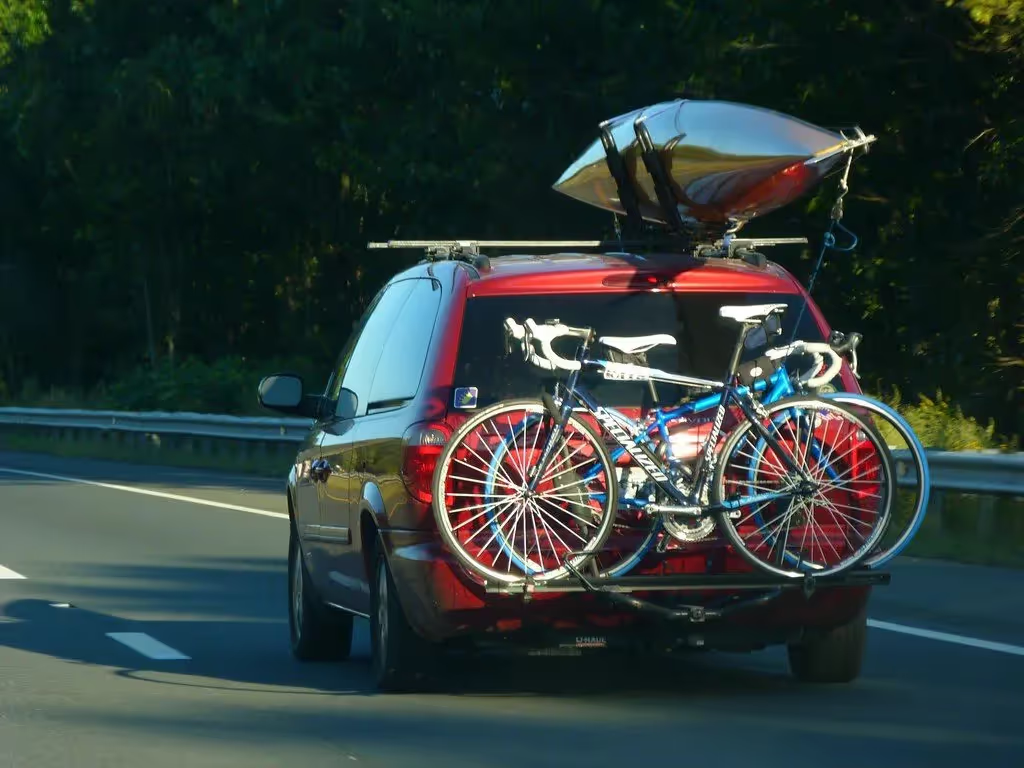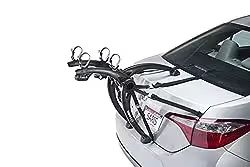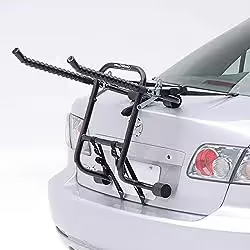Is My Bike Rack Legal? All You Need to Know to Avoid Trouble!

Before heading out on the road, you may realize that your bike rack is blocking the license plate. Do you need to worry about being pulled over and receiving a ticket?
If your bike rack is obstructing the view of your license plate, it may be illegal, depending on your country, state or province.
Did you know that having your bike rack obstructing your license plate could actually be illegal in some jurisdictions?
That's right, depending on where you live, you may need to take action to ensure your license plate is fully visible.
While some jurisdictions have exemptions that allow for partial obstruction of the license plate by a bike rack, many strictly prohibit any form of blocking.
Skip to: 5 ways to fix license place blocking
To avoid any potential legal trouble, it's crucial to familiarize yourself with the laws in your country, state or province.
License plate regulations in United States
License plate regulations in Canada
Number plate regulations in United Kingdom
In this article, I'll not only provide you with practical solutions to fix a license plate blocking issue but also help you understand what the regulations are depending on where you live.
U.S. State Regulations on License Plate Visibility
Here's a general overview of license plate visibility regulations across U.S. states.
Please note that this is a broad overview, and specific regulations can vary within states or change over time. Always consult the latest local regulations.
- Alabama: License plates must be clearly visible. Any obstruction, including by bike racks, could result in a citation.
- Alaska: License plates should be free from obstructions and clearly legible.
- Arizona: It's illegal to cover any portion of a license plate.
- Arkansas: License plates must be clearly visible at all times.
- California: License plates should be clearly visible and illuminated at night. Bike racks that obstruct view can result in a ticket.
- Colorado: License plates must be clearly legible and free from obstructions.
- Connecticut: Obstruction of license plates, including by bike racks, is not allowed.
- Delaware: License plates should be free from obstructions and clearly visible.
- Florida: It's illegal to have anything obstructing the license plate.
- Georgia: License plates must be clearly visible and unobstructed.
- Hawaii: License plates should be clearly legible and free from obstructions.
- Idaho: It's illegal to cover any portion of a license plate.
- Illinois: License plates must be clearly visible and illuminated at night.
- Indiana: Obstruction of license plates is not allowed.
- Iowa: License plates should be free from obstructions and clearly visible.
- Kansas: It's illegal to have anything obstructing the license plate.
- Kentucky: License plates must be clearly visible at all times.
- Louisiana: License plates should be clearly legible and free from obstructions.
- Maine: It's illegal to cover any portion of a license plate.
- Maryland: License plates must be clearly visible and unobstructed.
- Massachusetts: Obstruction of license plates, including by bike racks, is not allowed.
- Michigan: License plates should be free from obstructions and clearly visible.
- Minnesota: It's illegal to have anything obstructing the license plate.
- Mississippi: License plates must be clearly visible at all times.
- Missouri: License plates should be clearly legible and free from obstructions.
- Montana: It's illegal to cover any portion of a license plate.
- Nebraska: License plates must be clearly visible and unobstructed.
- Nevada: Obstruction of license plates is not allowed.
- New Hampshire: License plates should be free from obstructions and clearly visible.
- New Jersey: It's illegal to have anything obstructing the license plate.
- New Mexico: License plates must be clearly visible at all times.
- New York: License plates should be clearly legible and free from obstructions.
- North Carolina: It's illegal to cover any portion of a license plate.
- North Dakota: License plates must be clearly visible and unobstructed.
- Ohio: Obstruction of license plates, including by bike racks, is not allowed.
- Oklahoma: License plates should be free from obstructions and clearly visible.
- Oregon: It's illegal to have anything obstructing the license plate.
- Pennsylvania: License plates must be clearly visible at all times.
- Rhode Island: License plates should be clearly legible and free from obstructions.
- South Carolina: It's illegal to cover any portion of a license plate.
- South Dakota: License plates must be clearly visible and unobstructed.
- Tennessee: Obstruction of license plates is not allowed.
- Texas: License plates should be free from obstructions and clearly visible.
- Utah: It's illegal to have anything obstructing the license plate.
- Vermont: License plates must be clearly visible at all times.
- Virginia: License plates should be clearly legible and free from obstructions.
- Washington: It's illegal to cover any portion of a license plate.
- West Virginia: License plates must be clearly visible and unobstructed.
- Wisconsin: Obstruction of license plates, including by bike racks, is not allowed.
- Wyoming: License plates should be free from obstructions and clearly visible.
Canadian Regulations on License Plate Visibility
In Canada, license plate regulations are determined at the provincial and territorial level.
- Alberta: License plates must be clearly visible and unobstructed at all times.
- British Columbia: It's illegal to obstruct the view of a license plate. Plates should also be illuminated for nighttime visibility.
- Manitoba: License plates should be free from obstructions and clearly legible.
- New Brunswick: Obstruction of license plates, including by bike racks, is not allowed.
- Newfoundland and Labrador: License plates must be clearly visible and free from obstructions.
- Northwest Territories: License plates should be clearly legible and unobstructed.
- Nova Scotia: It's illegal to cover or obstruct any portion of a license plate.
- Nunavut: License plates must be clearly visible and unobstructed at all times.
- Ontario: License plates should be free from obstructions and clearly legible. They should also be kept clean.
- Prince Edward Island: It's illegal to obstruct the view of a license plate.
- Quebec: License plates must be clearly visible and free from obstructions.
- Saskatchewan: License plates should be clearly legible and unobstructed.
- Yukon: It's illegal to cover or obstruct any portion of a license plate.
Disclaimer: this is a general overview, and specific regulations can vary within provinces or territories or change over time. Always consult the latest local regulations or law enforcement agencies in the respective province or territory for the most accurate and up-to-date information.
Number Plate Visibility Regulations in the United Kingdom
In the UK, the regulations surrounding number plate visibility are more centralized, as they are set at the national level. From our research, here are following guidelines to consider.
- For legibility, it's a legal requirement for the number plate to be clearly visible and legible at all times. Any obstruction, including dirt or a bike rack, that prevents the plate from being read correctly is against the law.
- UK vehicles are required to display both front (white) and rear (yellow) number plates. Both should be unobstructed.
- The rear number plate must be illuminated at night to make it visible and legible in the dark.
- If a rear-mounted bike rack is used and it obstructs the number plate or the vehicle's lights, a supplementary lighting board displaying the number plate, brake lights, and indicators must be used.
- Your number plate is must be visible or it has to meet the required standards, other you can face fines and can fail the vehicle's MOT test.
The specific standards are set out by the DVLA (Driver and Vehicle Licensing Agency).
Types of Bike Racks That May Block the License Plate
If you’ve determined that your state has laws against blocking the license plate with a bike rack, you should know what types of bike racks this applies to. This is especially important if you haven’t purchased a bike rack yet or must purchase a new one to comply with state laws.
Also check out: Different types of bike racks
1. Hitch-Mounted Bike Racks
Hitch-mount bike racks are attached to the hitch on the back of your car and extend upward. Since the hitch is directly in the center of your vehicle, it typically sits right in front of the license plate.
This type of bike rack is the most common to block the license plate.
Although they typically don’t fully block the license plate when empty, they will obscure certain parts of it depending on the angle you’re looking at it.

Hitch-mount bike racks usually block the license plate more when the bikes are loaded. This could result in getting pulled over by police depending on the law in your state.
2. Trunk-Mounted Bike Racks
Trunk-mount bike racks are attached to the rear of the car using foam contact points and straps.
Although this type of rack commonly blocks the license plate, some trunk-mount racks have contact points that rest on top of the license plate. This can partially or fully obscure it, even without bikes loaded onto the rack.
There are versions of trunk-mount bike racks that are specifically designed to avoid blocking the license plate, which is discussed below. You should still check the law in your state, since the license plate may still be blocked once the bikes are loaded.
Bike Racks That Won’t Block the License Plate
There are some bike racks that are designed to avoid blocking the license plate. The license plate will always be blocked to some degree once the bikes are loaded if you’re using any type of rear-mounted bike rack, but there are also bike racks that avoid this issue entirely.
Roof-Mounted Bike Racks
Roof-mount bike racks are attached to the roof of your car instead of the rear.
This is the only option that will entirely avoid blocking the license plate under all conditions.
Roof-mount bike racks will allow you to leave the rear of your car free from any obstruction since the bike will rest on top of the car.
If your state has strict laws against blocking the license plate, this type of bike rack is best for you.
Also checkout: How Much Do Bike Racks Cost?
Trunk-Mounted Bike Racks
Some trunk-mount bike racks are designed for easy visibility of the license plate, especially when there are no bikes loaded.
Here are a few of the best trunk-mounted bike racks that won’t block the license plate.
1. Saris Bones bike rack

The contact points on the Saris Bones bike rack rest outside of the license plate, making it easy to view.
The Saris Bones is a very popular and safe trunk-mount bike rack. The rack is made of high-quality materials and is designed to be very sturdy and compact. It fits most cars and clears low-profile spoilers.
The Saris Bones come in a 3-bike capacity and 2-bike capacity.
Also check out: Best Trunk-Mount Bike Racks
2. Hollywood Racks F1B

The Hollywood Racks F1B bike rack also has contact points that rest outside of the license plate area. It is a great bike rack for the price that holds up to 3 bikes and fits most types of cars.
While the strapping mechanism is not as stable as the Saris Bones, the bike rack is cheaper. Consider your specific situation, such as how often you’ll use it or how far your trip is, to determine which bike rack might be best for you.
5 Ways to Fix a Bike Rack Blocking the License Plate
If your state has laws against blocking the license plate with a bike, you’ll need to fix it to avoid being pulled over by police and fined.
If you accidentally block your license plate with a bike rack or any other obstruction, it’s important to take the necessary steps to ensure compliance with traffic regulations and maintain safety on the road. Here’s what you can do:
1. Obtain a Temporary Paper License Plate
Some states allow you to obtain another license plate to remain visible when a bike rack is in use. You must typically pay a small fee and attach the temporary plate (made of paper) to the rear windshield.
This will allow police officers to see your license plate while your bike rack is attached and loaded with bikes. You will need to remove the temporary plate along with the bike rack when you are no longer hauling bikes or other cargo.
In some jurisdictions, you can use a transparent or removable license plate cover to protect the plate from dirt and debris while ensuring it remains visible.
2. Relocate the License Plate
If the license plate isn’t visible while your bike rack is attached, you may relocate it to make it visible again. The process of relocating depends on the type of vehicle and bike rack. You might be able to mount it temporarily on the rear of the bike rack or another visible spot on your vehicle’s rear.
This may be easy, but some states also require the license plate to be illuminated at night. This means you will have to make a system to keep light on the plate if you’re driving at night. Browse illuminated license plate brackets on Amazon.
You should also check for other laws in your state regarding the proper attachment and visibility of the license plate.
3. Adjust the bike rack
If possible, try adjusting the bike rack to a position where it doesn’t obstruct the license plate. Some hitch-mounted bike racks have adjustable arms or folding features that can help create clearance for the plate.
4. Use an extender or adapter
Consider using a license plate extender or adapter. These devices can be attached to the bike rack or hitch and provide a separate mounting location for your license plate, making it visible even when the bikes are loaded.
5. Purchase a More Suitable Bike Rack
If you are unable to properly relocate the license plate or obtain a temporary plate, you may simply have to purchase a new bike rack to avoid being fined by the police.
By purchasing a bike rack that won’t block the license plate, you’ll be able to avoid this issue entirely. You won’t have to worry about obtaining a temporary plate or relocating the license plate to be visible.
For many people, this may be the best long-term solution.
Browse bike racks that won’t block your license plate.
Other Ways Your Bike Rack May Be Illegal
Blocking the license plate may not be the only way your bike rack could violate the law.
Some states require bike racks to be removed when they are not in use. This means you shouldn’t be driving around with an empty bike rack. Check your state’s law to see if this applies to you.
Additionally, an unsafe bike rack can lead to legal problems.
Although an unsecured bike rack isn’t illegal itself, an improperly secured rack could violate the law when something goes wrong. If your bike rack fails, the bikes will fall onto the road, potentially damaging other cars or injuring others.
Unsecured loads on your car will also result in expensive fines and potentially even jail time! Unsecured load fines in the United States range from $10 to $5,000, with 16 states including jail time as a possible punishment (Source).
Although some states may not heavily enforce these laws, it’s important to think about them before hitting the road.
Summary of Navigating License Plate Visibility Laws for Bike Racks
Navigating the maze of license plate visibility regulations can be challenging, especially for sports junkies who travel frequently to different places with their gear.
But the easiest way to avoid trouble is to just check.
Whether you're in the U.S., Canada, or the UK, the overarching principle remains: license plates must be clearly visible and unobstructed.
While U.S. regulations vary by state and Canadian rules are set provincially, the UK has a centralized approach.
For those using bike, kayak or any other racks, some of the solutions include obtaining a temporary paper license plate, adjusting your rack, using extenders, or even purchasing a different rack altogether.









